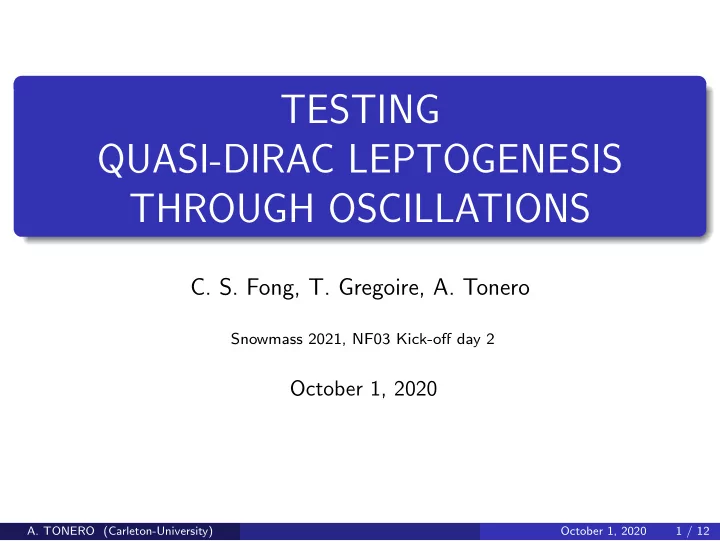

TESTING QUASI-DIRAC LEPTOGENESIS THROUGH OSCILLATIONS C. S. Fong, T. Gregoire, A. Tonero Snowmass 2021, NF03 Kick-off day 2 October 1, 2020 A. TONERO (Carleton-University) October 1, 2020 1 / 12
Dirac see-saw model [C.-S. Fong, T. Gregoire, AT arXiv:1903.12192] Neutrino masses generated through L-conserving Dirac see-saw L ) c + Heavy neutral leptons N R + light R-handed neutrinos ν R = ( ν ′ new singlet scalar Φ ′ (inspired by Mirror world models) M ν ≃ − υfY M − 1 Y ′ T Successful leptogenesis M 1 > 10 9 GeV A. TONERO (Carleton-University) October 1, 2020 2 / 12
Quasi-Dirac model [C.-S. Fong, T. Gregoire, AT arXiv:2007.09158] L-conserving lagrangian ( α = 1 , 2 , 3 i, j = 1 , ..N f ) i ¯ ∂N Ri + i ¯ Ri − M i ¯ N ′ ∂N ′ N Ri N ′ c N Ri / Ri / L = Ri + h . c . − y αj ¯ l Lα ˜ αj ¯ l ′ Lα ˜ Φ N Rj − y ′ Φ ′ N ′ Rj + h . c . L-violating lagrangian − 1 Ri N Rj − 1 2 m ij ¯ ij ¯ N c 2 m ′ N ′ c Ri N ′ / L = Rj y αi ¯ αi ¯ l Lα ˜ Φ N ′ y ′ l ′ Lα ˜ Φ ′ N Ri + h . c . − ˜ Ri − ˜ Assume m = m ′ , y = y ′ and ˜ y ′ and small L-violating terms y = ˜ | m | ≪ M | ˜ y | ≪ | y | A. TONERO (Carleton-University) October 1, 2020 3 / 12
Neutrino masses Realistic model requires N f ≥ 2 . We have M ν ≃ − υ 2 Y M − 1 Y T where � y � � � y ˜ m M Y = M = M T y ˜ y m Diagonalization � ν Lα � Ω A � � 3 × 6 = Ω αi ν i Ω = ν ′ Ω S 3 × 6 Lα where Ω is a 6 × 6 unitary matrix such that Ω † M ν Ω ∗ = diag( m 1+ , m 1 − , m 2+ , m 2 − , m 3+ , m 3 − ) Pseudo-Dirac pairs m i ± = m i ± δm i δm i ≪ m i A. TONERO (Carleton-University) October 1, 2020 4 / 12
N f = 1 leptogenesis Heavy singlet fermions split into quasi-Dirac pair N ± M ± ≃ M ± | m ′ + m ∗ | 2 CP violating decays ( N ± → l α Φ , ¯ l α ¯ Φ ) ǫ = Γ − ¯ Γ y ˜ � Γ + ¯ Γ y Baryon asymmetry n B ∝ ǫ Maximal value for ∆ M ≃ Γ (resonant enhancement) ˜ y | ǫ max | ≃ y A. TONERO (Carleton-University) October 1, 2020 5 / 12
N f = 1 neutrino masses Two massive light neutrinos also split into quasi-Dirac pair m ∓ = m ν ∓ δm where y 2 v 2 yy | υ 2 /M m ν ≡ δm ≃ 2 | ˜ M Intriguing relation between the CP parameter and neutrino mass splitting | ǫ max | ≃ δm 2 m ν A. TONERO (Carleton-University) October 1, 2020 6 / 12
Results [arXiv:2007.09158] Regions of sufficient baryon asymmetry 10 − 12 eV 2 10 − 10 eV 2 10 − 8 eV 2 10 − 6 eV 2 δm/ (2 m ν ) m ν (eV) M ≫ 1 TeV (gray), M = 1 TeV (blue) and M = 500 GeV (light blue) for zero (solid) and thermal (short dashed) initial N i abundance. A. TONERO (Carleton-University) October 1, 2020 7 / 12
Proposed study Explore the full parameter space ( M, m, y, ˜ y ) for N f = 2 and N f = 3 taking into account leptogenesis, neutrino masses and oscillation constraints N 2 ± and N 3 ± leptogenesis Oscillations depend on δm i and Ω A 1 Ω A = � � √ A ( U P MNS + B ) iA ( U P MNS − B ) 2 A, B depend on additional 9 angles and 9 phases ... A. TONERO (Carleton-University) October 1, 2020 8 / 12
Thank you A. TONERO (Carleton-University) October 1, 2020 9 / 12
BACK UP A. TONERO (Carleton-University) October 1, 2020 10 / 12
Quasi-Dirac oscillations fit and constraints Phenomenological study [Anamiati, Fonseca, Hirsch 1710.06249] A. TONERO (Carleton-University) October 1, 2020 11 / 12
Phenomenology LFV can be induced at one-loop level through loop of heavy quasi-Dirac fermions N 6 × 10 − 26 � m ν � 2 � 2 � 500 GeV Br( µ → eγ ) ≈ 0 . 1 eV M Current experimental bound Br( µ → eγ ) < 4 . 2 × 10 − 13 Neutrinoless beta decay rate is prop to y e v 2 ( M ν ) ee ≃ − 2 y e ˜ M suppressed by ˜ y e ≪ y e , not likely to be measured even in the next generation experiments which aim to probe ( M ν ) ee ∼ 10 meV A. TONERO (Carleton-University) October 1, 2020 12 / 12
Recommend
More recommend